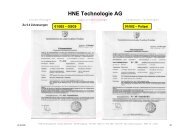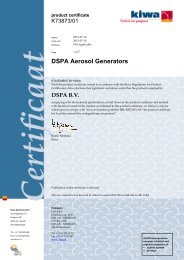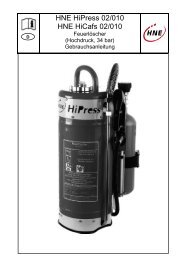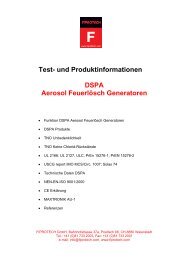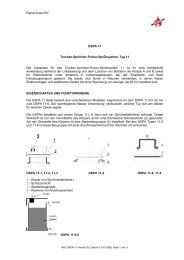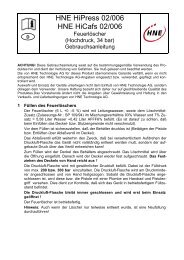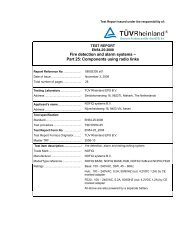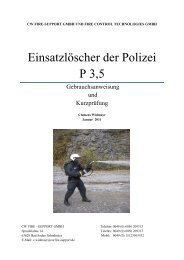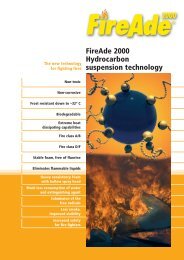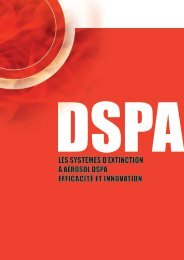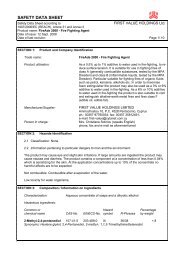NOFIQ Fire Detection and Extinguishing System
NOFIQ Fire Detection and Extinguishing System
NOFIQ Fire Detection and Extinguishing System
You also want an ePaper? Increase the reach of your titles
YUMPU automatically turns print PDFs into web optimized ePapers that Google loves.
Kiwa Nederl<strong>and</strong> B.V.<br />
Sir W. Churchill-laan 273<br />
Postbox 70<br />
2280 AB RIJSWIJK ZH<br />
The Netherl<strong>and</strong>s<br />
Tel. +31-70 414 44 00<br />
Fax +31-70 414 44 20<br />
E-mail info@kiwa.nl<br />
www.1kiwa.com<br />
Number K56953/01 Replaces --<br />
Date of issue 2010-09-17 Date --<br />
Product Certificate<br />
<strong>NOFIQ</strong> <strong>Fire</strong> <strong>Detection</strong> <strong>and</strong> <strong>Extinguishing</strong> <strong>System</strong><br />
Based on inspections, as well as regularly performed checks by Kiwa,<br />
the products supplied by<br />
<strong>NOFIQ</strong> <strong>Fire</strong> & Safety <strong>System</strong>s B.V.<br />
specified in this certificate <strong>and</strong> provided with the under “Marks” defined<br />
Kiwa-mark, may on delivery be relied upon to comply with the Kiwa<br />
Evaluation Guideline BRL-K21014/04 “for the Kiwa product certificate for<br />
aerosol fire-extinguishing systems for fire protection in enclosed<br />
compartments containing electrical components”.<br />
Bouke Meekma<br />
Director Kiwa Nederl<strong>and</strong> B.V.<br />
This certificate is issued in accordance with the Kiwa-Regulations for Product<br />
Certification.<br />
This certificate consists of 9 pages.<br />
Publication of the certificate is allowed.<br />
Company<br />
<strong>NOFIQ</strong> <strong>Fire</strong> & Safety <strong>System</strong>s B.V.<br />
Phileas Foggstraat 8<br />
7821 AK EMMEN<br />
Postbus 6572<br />
6503 GB NIJMEGEN<br />
Tel. 024 352 25 74<br />
Fax 024 378 75 83<br />
sales@nofiq.com<br />
www.nofiq.com
Pagina 2 Number K56953/01 Replaces --<br />
Date of issue 2010-09-17 Date --<br />
<strong>NOFIQ</strong> <strong>Fire</strong> <strong>Detection</strong> <strong>and</strong> <strong>Extinguishing</strong> <strong>System</strong><br />
PRODUCTSPECIFICATION GENERAL<br />
The requirements mentioned in this Evaluation Guideline are operated by Kiwa when h<strong>and</strong>ling a request or upkeep for the Kiwa product certificate<br />
(EN 45011) for aerosol fire-extinguishing systems for fire protection in enclosed compartments containing electrical components (aerosol fire-<br />
extinguishing system). This system is designed as an additional monitoring <strong>and</strong> fire-extinguishing system.<br />
The system consists of the following components.<br />
1. <strong>Fire</strong>-extinguishing component (FEC) containing:<br />
a) Aerosol fire-extinguishing component for extinguishing;<br />
b) <strong>Fire</strong> alarm extinguishing station for driving the aerosol fire-extinguishing component <strong>and</strong> other drivers;<br />
c) <strong>Detection</strong> component for monitoring <strong>and</strong> guarding the object.<br />
2. Signal repeater (HUB)<br />
3. Alarm management system (AMS) with radio interface (AMS-HUB)<br />
Component 1 can be used autonomously (st<strong>and</strong>alone) as well, without using the components 2 <strong>and</strong> 3.<br />
Alarm follow-up can be guaranteed by means of other communication equipment.<br />
The communication equipment must meet the requirements from the st<strong>and</strong>ards PrEN 54-13, EN 54-18 <strong>and</strong> EN 54-21.<br />
This communication equipment is usually provided by the alarm receiving station.<br />
Application in conjunction with other systems<br />
The application of components according to Evaluation Guideline BRL-K21014 in <strong>Fire</strong> detection <strong>and</strong> fire alarm systems according CEN/TS 54-14<br />
“<strong>Fire</strong> detection <strong>and</strong> fire alarm systems - Part 14: Guidelines for planning, design, installation, commissioning, use <strong>and</strong> maintenance” is possible<br />
because the components certified according to Evaluation Guideline BRL-K21014 comply with the relevant European st<strong>and</strong>ards.<br />
The connection between the components according Evaluation Guideline BRL-K21014 <strong>and</strong> the <strong>Fire</strong> detection <strong>and</strong> fire alarm systems according<br />
CEN/TS 54-14 (for the Netherl<strong>and</strong>s NEN2535) has to be according to EN54-18 “<strong>Fire</strong> detection <strong>and</strong> fire alarm systems - Part 18: Input/output devices”.<br />
The maximum combined number of fire-extinguishing components (FEC) <strong>and</strong> signal repeaters (HUB) within one system is 511. Within a system<br />
configuration the transmission path between a fire-extinguishing component <strong>and</strong> the alarm management system is limited to a maximum of 32 signal<br />
repeaters (HUB). The system has to communicate on a licence-free frequency b<strong>and</strong> (ISM frequency) for which wireless communication for alarm<br />
purposes is permitted. The aerosol fire-extinguishing system should be constructed in such a way that the radio connection as transmission path is<br />
carried out redundantly.<br />
The system is tested <strong>and</strong> proven in the following dimensioning <strong>and</strong> projection. These dimensioning <strong>and</strong> projection fall within the scope of the product<br />
certificate. The number of fire-extinguishing components (FEC) needed for a specific object also determines the projection, i.e. the position <strong>and</strong><br />
direction in which the FEC’s must be mounted. When applying 1 FEC it will be placed in the middle of the object on the upper side, having the outflow<br />
openings pointing to the left <strong>and</strong> the right. Ensure that both outflow openings of the FEC have at least 15 cm of free outflow space in order to prevent<br />
damage to equipment. The antenna has to be connected to the FEC by means of an antenna extension cord. When applying 2 or more FEC’s these<br />
are placed on the side of the object to be protected, having the outflow openings pointing upwards <strong>and</strong> downwards. Ensure that both outflow<br />
openings of the FEC have at least 15 cm of free outflow space in order to prevent damage to equipment. When applying more than 1 FEC in a<br />
cabinet these must be linked by means of a bus connection.
Pagina 3 Number K56953/01 Replaces --<br />
Date of issue 2010-09-17 Date --<br />
<strong>NOFIQ</strong> <strong>Fire</strong> <strong>Detection</strong> <strong>and</strong> <strong>Extinguishing</strong> <strong>System</strong><br />
PRODUCTSPECIFICATIONS FE20<br />
The test cupboard for the FE20 with the st<strong>and</strong>ard projection for detection <strong>and</strong> extinguishing.<br />
The test cupboard for the FE20 with the st<strong>and</strong>ard projection for detection <strong>and</strong> extinguishing.
Pagina 4 Number K56953/01 Replaces --<br />
Date of issue 2010-09-17 Date --<br />
<strong>NOFIQ</strong> <strong>Fire</strong> <strong>Detection</strong> <strong>and</strong> <strong>Extinguishing</strong> <strong>System</strong><br />
De FE20 is tested under following conditions to determine if detection is within the requirements of Evaluation Guideline BRL-K21014.<br />
The following conditions have been used:<br />
• TF1, wood crib (source 7 according to BS 5852-2:1990).<br />
• TF4, polyurethaan mats (comparable with NEN 2535:1996 <strong>and</strong> EN 54-7:2000).<br />
• TF7, methylated spirit 85% (comparable with NEN 2535:1996).<br />
• TF10, print with 5 resistors (comparable with NEN 2535:1996).<br />
PRODUCTSPECIFICATIONS FE80<br />
The tests for the FE80 are carried out in a test cabinet (D 0,8 m x B 1,60 (2 x 0,8 m)X H 2 m) as shown in the figure below.<br />
The test cabinet has a transparent window in the middle of the door, so the test carried out inside the test cabinet can be observed visually.<br />
The cabinet itself contains no electrical components. The cabinet has sufficient space for thermal propulsion.<br />
The test cabinet 1 <strong>and</strong> 2 are provided with a ventilator with the following specifications (air speed with filter 55 m3/h, 230 V, 50/60 Hz, temperature<br />
range -10˚C - + 55˚C).<br />
These ventilators (Rittal 3322.107) are placed at the bottom of the test cabinet <strong>and</strong> will blow air into the test cabinet.<br />
At the upper side of each test cabinet an air grid is placed (Rittal 3322.207) with the same diameter as the ventilator for outflow of air <strong>and</strong> other<br />
gases. The test cabinets are connected to each other without an internal barrier.<br />
These tests are conclusive for the st<strong>and</strong>ard projection belonging to this system.<br />
The FE80 is tested under following conditions to determine if detection is within the requirements of Evaluation Guideline BRL-K21014.<br />
The following conditions have been used:<br />
• TF1, wood crib (source 7 according to BS 5852-2:1990).<br />
• TF4, polyurethaan mats 3 x 4 van 100 x 100 mm <strong>and</strong> thick 20 mm (comparable with NEN 2535:1996 <strong>and</strong> EN 54-7:2000).<br />
• TF7, methylated spirit 85% (comparable with NEN 2535:1996).*<br />
• TF10, print with 5 resistors (comparable with NEN 2535:1996).<br />
*TF7 has a limited scope. For the scope TF 7 will detection be functional within 2 minutes with only one ventilator operational. This is for the<br />
specific use for fire detection of flammable liquids.
Pagina 5 Number K56953/01 Replaces --<br />
Date of issue 2010-09-17 Date --<br />
<strong>NOFIQ</strong> <strong>Fire</strong> <strong>Detection</strong> <strong>and</strong> <strong>Extinguishing</strong> <strong>System</strong><br />
The test cupboard for the FE80 with fixed projection for detection <strong>and</strong> extinguishing.<br />
APPLICATION AND USE<br />
Full title<br />
The full title of this Evaluation Guideline is the Kiwa product certificate for aerosol fire-extinguishing systems with wireless communication to an alarm<br />
management system for fire protection in enclosed compartments containing electrical components (maximum 1500 Volts DC <strong>and</strong> 1000 Volts AC).<br />
Product aim<br />
The aerosol fire-extinguishing system should monitor the environment to be protected for fire phenomena by detecting these <strong>and</strong> then communicate<br />
with other equipment within the system with the purpose to alarm in an initial phase of fire, notify a receiving station for fire alarms, extinguish in the<br />
fire phase <strong>and</strong> control during a set period.<br />
The application is primarily meant for objects that cannot be entered by humans <strong>and</strong> fall under the definition “un-enterable room”.<br />
More specifically the objective is as follows:<br />
Early detection (with wireless fire alarm system with detection based on % CO <strong>and</strong> ∆T/Tmax) for fire sizes as stated in appendix 15. The<br />
extinguishing system should prevent an expansion of the fire outside the cabinet during the st<strong>and</strong>ing time of the extinguishing agent.
Pagina 6 Number K56953/01 Replaces --<br />
Date of issue 2010-09-17 Date --<br />
<strong>NOFIQ</strong> <strong>Fire</strong> <strong>Detection</strong> <strong>and</strong> <strong>Extinguishing</strong> <strong>System</strong><br />
The aerosol fire-extinguishing system is aimed for application in compartments such as:<br />
• Switch cabinets;<br />
• Computers;<br />
• Meter boxes.<br />
Starting-point in this is a st<strong>and</strong>ard projection (see appendices 15 <strong>and</strong> 16) for detection <strong>and</strong> for extinguishing. It therefore concerns a pre-engineered<br />
system. The installation of the aerosol fire-extinguishing system should be described in the supplier’s manual. The users will be instructed in design,<br />
installation, acceptance <strong>and</strong> follow-up by means of a training by the supplier. For an integral safety concept, this training should be applied in<br />
combination with this Evaluation Guideline.<br />
Explanation: If the detection system does not function, the system shall be activated by means of a thermal cord. If this thermal cord refuses,<br />
activation takes place based on the aerosols own activation temperature. The values must be declared in the product certificate of the aerosol-<br />
extinguishing agent as per Evaluation Guideline BRL-K23001. Additionally the product certificate must give insight in dimensioning of the system.<br />
The aerosol fire-extinguishing system should be able to function in an indoor environment meeting the following conditions.<br />
Conditions FEC HUB AMS<br />
Use<br />
Temperature -10°C to +45°C# -10°C to +60°C -10°C to +60°C<br />
Air humidity
Pagina 7 Number K56953/01 Replaces --<br />
Date of issue 2010-09-17 Date --<br />
<strong>NOFIQ</strong> <strong>Fire</strong> <strong>Detection</strong> <strong>and</strong> <strong>Extinguishing</strong> <strong>System</strong><br />
Relevant st<strong>and</strong>ards are;<br />
St<strong>and</strong>ard number St<strong>and</strong>ard title Year<br />
BRL-K23001/03 Autonomous stationary extinguishing systems based on dry aerosols 2005<br />
UL 2775 Outline of investigation for fixed condensed aerosol extinguishing units issue no. 1.<br />
2008<br />
CEN/TR 15276-1 Fixed fire fighting systems - Condensed aerosol extinguishing systems - Part 1: requirements <strong>and</strong><br />
2008<br />
ISO 2859-1<br />
test methods for components<br />
Sampling procedures for sampling attributes – part 1: sampling schemes indexed by expectance<br />
quality limit (AQL) for lot by lot inspection<br />
1999<br />
NEN 3011 Safety colors <strong>and</strong> safety signs 1986<br />
NEN 5509 User manuals – Content, structure, formulation <strong>and</strong> presentation 1998<br />
CEI/IEC 62079 Preparation of instructions structure ring, content <strong>and</strong> presentation 2001<br />
IEC 60529 Consolidated Edition Degrees of protection provided by enclosures (IP Code) Applies to the<br />
classification of degrees of protection provided by enclosures for electrical equipment with a rated<br />
voltage not exceeding 72,5 kV. Has the status of a basic safety publication in accordance with<br />
IEC Guide 104<br />
2001<br />
NEN - EN 54-2 <strong>Fire</strong> detection <strong>and</strong> fire alarm systems - Part 2: Control <strong>and</strong> indicating equipment (including<br />
correction document)<br />
1999<br />
NEN - EN 54-4 <strong>Fire</strong> detection <strong>and</strong> fire alarm systems - Part 4: Power supply equipment (including correction<br />
document)<br />
2002<br />
NEN - EN 54-5 <strong>Fire</strong> detection <strong>and</strong> fire alarm systems - Part 5: Thermal alarm devices - Point detectors 2001<br />
PrNEN - EN 54-13 <strong>Fire</strong> detection <strong>and</strong> fire alarm systems - Part 13: Compatibility of system components 2001<br />
PrNEN - EN 54-18 <strong>Fire</strong> detection <strong>and</strong> fire alarm systems - Part 18: Input/output devices 2003<br />
PrNEN - EN 54-21 <strong>Fire</strong> detection <strong>and</strong> fire alarm systems - Part 21: Alarm transmission <strong>and</strong> fault warning routing<br />
equipment<br />
2004<br />
NEN - EN 54-25 <strong>Fire</strong> detection <strong>and</strong> fire alarm systems - Part 25: Components using radio links <strong>and</strong> system<br />
requirements<br />
2008<br />
NEN – EN 12094-1 Fixed fire-fighting systems - Components for gas extinguishing systems -<br />
Part 1: Requirements <strong>and</strong> test methods for electrical automatic control <strong>and</strong> delay devices<br />
2003<br />
IEC 60068-1-1 Basic Environmental testing procedures – 1998 Part 1: general <strong>and</strong> guidance 1998+A1: 1992<br />
IEC 60068-2-1 Environmental testing – Part 2-1: Tests – Tests A: Cold (inclusive correction document) 1990<br />
IEC 60068-2-2 Basic environmental testing procedures – Part 2-2: Tests – Tests B: Dry Heat d (inclusive<br />
correction document)<br />
1974<br />
IEC 60068-2-6 Environmental testing – Part 2-6: Tests – Tests A:Fc: Vibration (sinusoidal), (inclusive correction<br />
document)<br />
1996<br />
IEC 60068-2-27 Environmental testing – Part 2-27: Tests – Tests Ea: Shock 1987<br />
IEC 60068-2-30 Environmental testing – Part 2-30: Tests – Tests Db <strong>and</strong> guidance Damp heat cyclic 1980<br />
IEC 60068-2-32 Environmental testing – Part 2-32: Tests – Tests Ed: Free Fall 1993<br />
IEC 60068-2-42 Environmental testing – Part 2-42: Test methods – Tests Kc: Sulphur dioxide test for contacts<br />
<strong>and</strong> connections<br />
2002<br />
IEC 60068-2-75 Environmental testing – Part 2-75: Tests – Tests Eh: Hammer Test 1997<br />
IEC 60068-2-78 Environmental testing – Part 2-78: Tests – Tests Cab: Damp Heat, steady state 2001<br />
IEC 61340-5-2 Electrostatics – Part 5-2: Protection of electronic devices from electrostatic phenomena – User<br />
guide<br />
2001<br />
EN 2 <strong>Fire</strong> classes 1994<br />
MARKING<br />
The products shall be marked with the following label.
Pagina 8 Number K56953/01 Replaces --<br />
Date of issue 2010-09-17 Date --<br />
<strong>NOFIQ</strong> <strong>Fire</strong> <strong>Detection</strong> <strong>and</strong> <strong>Extinguishing</strong> <strong>System</strong><br />
Place of the mark:<br />
The packaging must be appropriate for its use, which is at least: transport with a container for road, ship <strong>and</strong> air freight.<br />
Furthermore packaging must reckon with transport of aerosol components.<br />
The packaging must contain stickers that offer a safety instruction for the system’s use. The stickers must be attached to the outside <strong>and</strong> inside of the<br />
object to be protected <strong>and</strong> should read: “AUTOMATIC FIRE-EXTINGUISHING SYSTEM, in case of fire or alarm, do not panic, close door(s) <strong>and</strong> alert<br />
expert assistance”.<br />
If special measures are necessary for preservation, those must be stated in the working instructions <strong>and</strong> on the identification label of the packaging.<br />
The identification on the housing <strong>and</strong>/or packaging must clearly state the following issues:<br />
Compulsory indications:<br />
Housing Packaging Indication<br />
X Qualification on the FEC based on EN2<br />
X X Name certified supplier<br />
X Address <strong>and</strong> telephone number certified supplier<br />
X X Model / type number<br />
X Number of pieces<br />
X X Building year / date of production<br />
X CE + number institution in question<br />
X X L<strong>and</strong> of production<br />
X Compulsory information based on R&TTE, EMC <strong>and</strong> LVD directives<br />
The certified products must be provided with the label, stating “BRL-K21014”.<br />
Manual<br />
The product is exclusively supplied to customers who are qualified by the supplier. In this qualification, it must be settled that the customer has<br />
received <strong>and</strong> understood the installation <strong>and</strong> user manual. The manual for design, installation, acceptance, use <strong>and</strong> maintenance must meet the<br />
requirements stated in NEN 5509: 1998 <strong>and</strong> CEI-IEC 62079: 2001.<br />
Furthermore, the manual must offer compulsory information based on the R&TTE, EMC <strong>and</strong> LVD directives.<br />
Method of marking:<br />
• Non-erasable;<br />
• Clear <strong>and</strong> according to the certification scheme<br />
RECOMMENDATIONS FOR CUSTOMERS:<br />
1. Check at the time of delivery whether:<br />
1.1 the producer has delivery in accordance with the<br />
agreement;<br />
1.2 the mark <strong>and</strong> the marking method are correct;<br />
1.3 the products show no visible defects as a result of transport<br />
etc.<br />
2. If you should reject a product on the basis of the above, please<br />
contact:<br />
2.1 <strong>NOFIQ</strong> <strong>Fire</strong> & Safety <strong>System</strong>s B.V.<br />
<strong>and</strong>, if necessary,<br />
2.2 Kiwa Nederl<strong>and</strong> B.V.<br />
3. Consult the producer's processing guidelines for the proper storage<br />
<strong>and</strong> transport methods.<br />
4. Check whether this certificate is still valid by consulting<br />
www.1kiwa.com
Pagina 9 Number K56953/01 Replaces --<br />
Date of issue 2010-09-17 Date --<br />
<strong>NOFIQ</strong> <strong>Fire</strong> <strong>Detection</strong> <strong>and</strong> <strong>Extinguishing</strong> <strong>System</strong><br />
ADDITIONAL APPROVAL / CERTIFICATION / LISTING OF THE<br />
PRODUCT<br />
The <strong>NOFIQ</strong> <strong>Fire</strong>-extinguishing system has the following additional<br />
approval /certification / listing;<br />
• Grant of Equipment Authorization. Certification Issued Under the<br />
Authority of the Federal Communications Commission Grantee<br />
Code W6O-102020A, N20-Base_Hub; date 4 April 2009.<br />
• Grant of Equipment Authorization. Certification Issued Under the<br />
Authority of the Federal Communications Commission Grantee<br />
Code W6O-102030A, N20-HUB; date 7 April 2009.<br />
• Grant of Equipment Authorization. Certification Issued Under the<br />
Authority of the Federal Communications Commission Grantee<br />
Code W6O-102040A, ZigBee <strong>Fire</strong> Control <strong>and</strong> Indicating<br />
Apparatus; date 7 April 2009.<br />
INTERGRATED APPROVAL / CERTIFICATION / LISTING OF THE<br />
PRODUCT<br />
• LETTER OF OPINION; Issued by TÜV Rheinl<strong>and</strong> EPS B.V.<br />
Date: January 4, 2008, Reference number 0707050101 based<br />
R&TTE DIRECTIVE.<br />
• LVD TCF CERTIFICATE; Issued by TÜV Rheinl<strong>and</strong> EPS B.V.<br />
Date: January 04, 2008; Certificate number 0707050103.<br />
• STATEMENT OF COMPLIANCE; Issued by TÜV Rheinl<strong>and</strong><br />
EPS B.V. Date : January 04, 2008; Certificate number<br />
0707050102




